Search
- Page Path
-
- HOME
- Search
- Review Article
- Cardiology
- Lifelong impact of elevated blood pressure from childhood to adulthood
- Junhyun Kwon, Eunji Kim
- Clin Exp Pediatr. 2025;68(4):278-286. Published online November 28, 2024
-

· Childhood blood pressure (BP) is significantly associated with adult hypertension and cardiovascular disease.
· Despite ongoing debate regarding the need for regular BP screening and early pharmacotherapy in children, the benefits of optimizing BP throughout childhood are clear.
· Childhood presents a critical window for normalizing BP through lifestyle modifications such as reducing sodium intake and increasing physical activity to promote lifelong cardiovascular health and prevent longterm complications.
- Original Article
- Gastroenterology
- Outcome of pediatric inflammatory bowel disease in Asian children: a multinational 1-year follow-up study
- Pornthep Tanpowpong, Suporn Treepongkaruna, James Guoxian Huang, Kee Seang Chew, Karen Sophia Calixto Mercado, Almida Reodica, Shaman Rajindrajith, Wathsala Hathagoda, Yoko Kin Yoke Wong, Way Seah Lee, Marion Margaret Aw
- Clin Exp Pediatr. 2025;68(3):247-256. Published online November 13, 2024
-

Question: Short-term (1-year) follow-up data in pediatric patients with inflammatory bowel disease (IBD), especially in Southeast Asian countries, are limited.
Finding/Meaning: Abdominal pain and pallor rates remained high at 1 year after IBD diagnosis. Three independent factors of 1-year clinical remission for Crohn disease were oral prednisolone, antibiotic, and immunomodulator use at 1-year follow-up. A history of weight loss at diagnosis was the only independent risk factor of IBD flare.
- Neonatology (Perinatology)
- Effect of high-frequency oscillatory ventilation with intermittent sigh breaths on carbon dioxide levels in neonates
- Kulthida Baingam, Anucha Thatrimontrichai, Manapat Praditaukrit, Gunlawadee Maneenil, Supaporn Dissaneevate
- Clin Exp Pediatr. 2025;68(2):178-184. Published online November 13, 2024
-
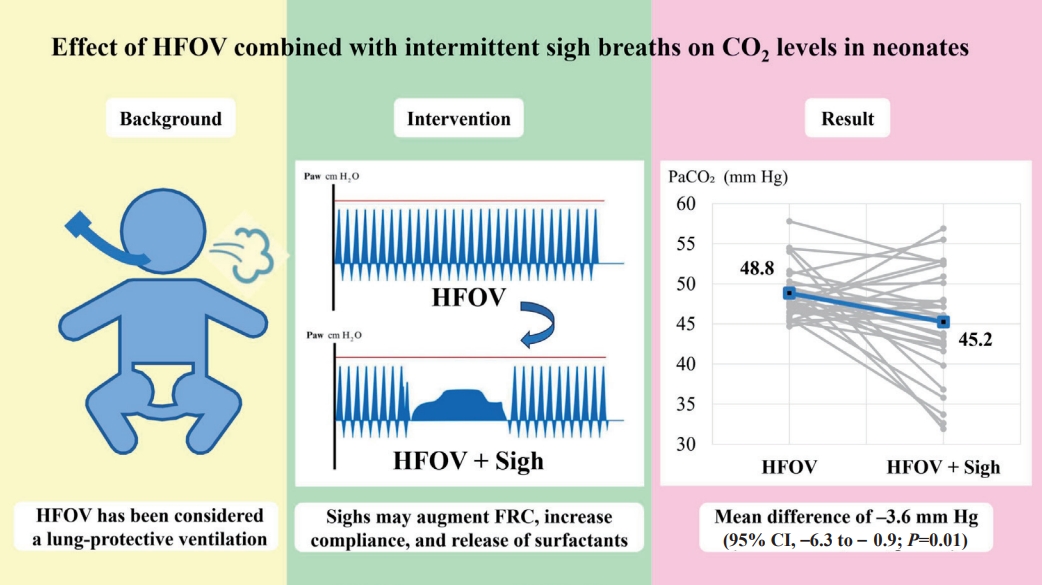
Question: Can sigh breaths (Sighs) application during high-frequency oscillatory ventilation (HFOV) decrease partial pressure of carbon dioxide (PaCO2) levels?
Finding: The mean PaCO2 level after Sighs during HFOV was significantly decreased compared to that after HFOV alone (mean difference, -3.6 mmHg).
Meaning: HFOV plus Sighs functionality can reduce PaCO2 levels. However, further studies are required to conclusively determine the effects of Sighs.
- Review Article
- Infection
- Incidence, causative organisms, and risk factors of bloodstream infections in pediatric liver transplant patients: a systematic review
- Mohamad Shieb, Rand Hasanain, Zara Arshad, Faisal A. Nawaz, Rahul Kashyap, Eric J. Stern
- Clin Exp Pediatr. 2024;67(9):427-434. Published online April 5, 2024
-

The overall incidence of bloodstream infections was 23.5%. Gram-negative organisms occur at a much higher rate in pediatric liver transplant recipients then that the general pediatric population. However, when comparing pediatric and adult liver transplant recipients Gram-positive organisms occur with a much higher rate in the pediatric population highlighting the importance of early and broad spectrum antimicrobial coverage when bloodstream infections are suspected.
- Original Article
- Hematology
- Changes and correlations of T-cell coinhibitory molecule programmed death-1 and interferon-γ in pediatric immune thrombocytopenia
- Fady Mohamed El-Gendy, Amira M.F. Shehata, Esam Awad Abd El-Kawy, Mahmoud Ahmed El-Hawy
- Clin Exp Pediatr. 2023;66(3):127-133. Published online February 24, 2023
-

Question: What are the PD-1+ CD4+ T cells percentages and serum interferon gamma (IFN-γ) levels of pediatric patients with immune thrombocytopenia (ITP)?
Finding: Compared with healthy controls, the PD-1+ CD4+ T cells percentages and IFN-γ levels were significantly higher in ITP patients before and 1 month after therapy.
Meaning: Our findings suggest that PD-1+ CD4+ T cells and IFN-γ are involved in the pathophysiological process of ITP.
- Review Article
- Nephrology (Genitourinary)
- Neonatal hypertension: concerns within and beyond the neonatal intensive care unit
- Kathleen Altemose, Janis M. Dionne
- Clin Exp Pediatr. 2022;65(8):367-376. Published online May 30, 2022
-
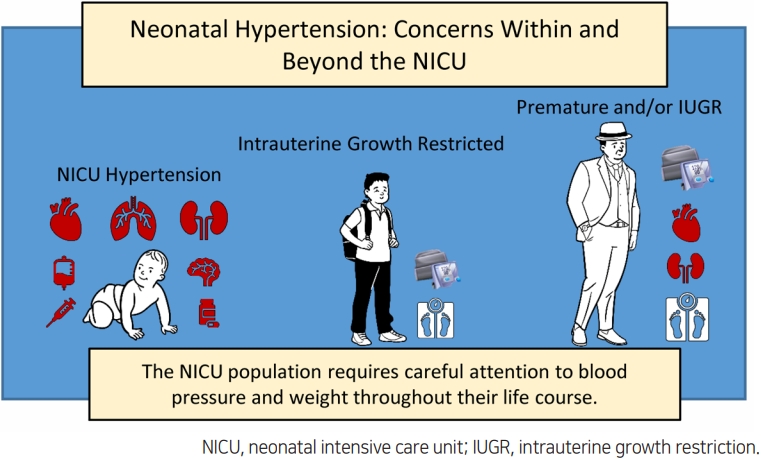
Some neonates, especially those who are premature, may experience hypertension while in the neonatal intensive care unit (NICU). The most common causes are prematurity-related and the hypertension usually resolves over the first 1–2 years of life. Unfortunately, the increasing population of NICU graduates is at risk for later cardiovascular and kidney disease in childhood and adulthood. This population requires careful attention to blood pressure and weight throughout their life course.
- Endocrinology
- Pediatric hypertension based on Japanese Society of Hypertension Guidelines (JSH 2019) with actual school blood pressure screening data in Japan
- Toru Kikuchi
- Clin Exp Pediatr. 2022;65(6):283-290. Published online November 26, 2021
-

The prevalence of Japanese pediatric hypertension is 0.9% based on proper measurement protocols. Hypertensive children tend to be hypertensive adults. Pediatric essential hypertension is characterized by an absence of symptoms, obesity, a family history of hypertension, and a low birth weight. The most common causes of pediatric secondary hypertension are renal parenchymal and renovascular diseases. Important factors controlling pediatric hypertension include healthy lifestyle modifications and pharmacotherapy.
- Nephrology (Genitourinary)
- Blood pressure measurements and hypertension in infants, children, and adolescents: from the postmercury to mobile devices
- Seon Hee Lim, Seong Heon Kim
- Clin Exp Pediatr. 2022;65(2):73-80. Published online September 15, 2021
-

· Hypertension is defined as a blood pressure (BP) >90th (elevated) or 95th (hypertension) percentile in children by height, age, and sex and >95th percentile in neonates by age, birth weight, and sex.
· Although the oscillometric method can be used for screenings, the auscultatory method remains the gold standard. The hybrid method employs the auscultatory and electronic methods and can reduce bias.
· BP measurement mobile device applications have a potential for development.
- Original Article
- Cardiology
- Age-, sex-, and height-based blood pressure reference charts, Yazd children 6–18 years, Iran
- Nastaran ahmadi, Seyedeh Mahdieh Namayandeh, Seyed Mahmood Sadr Bafghi, Mohammad Reza Mohammadi, Masoud Mirzaei, Mohammadtaghi Sarebanhassanabadi, Amir Houshang Mehrparvar, Reza Faraji, Neda Nilforoshan, Ahmad Karimi
- Clin Exp Pediatr. 2020;63(8):321-328. Published online July 21, 2020
-
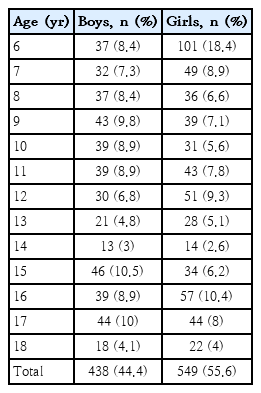
Question: What is the 90th, 95th, 99th percentile of blood pressure based on height as the cut point for diagnosis of hypertension in children of our province?
Finding: We used blood pressure of 456 males and 579 females in 6–18 years old in “Iranian Children and Adolescents' Psychiatric Disorders survey.
Meaning: The 90th, 95th, 99th percentiles of systolic and diastolic blood pressure in both sex based on age and 10-cm height intervals were developed in Yazd.
- Review Article
- Hematology
- Genetic classification and confirmation of inherited platelet disorders: current status in Korea
- Ye Jee Shim
- Clin Exp Pediatr. 2020;63(3):79-87. Published online February 6, 2020
-

Inherited platelet disorders (IPDs), which manifest as primary hemostasis defects, often underlie abnormal bleeding and a family history of thrombocytopenia, bone marrow failure, hematologic malignancies, undefined mucocutaneous bleeding disorder, or congenital bony defects. Wide heterogeneity in IPD types with regard to the presence or absence of thrombocytopenia, platelet dysfunction, bone marrow failure, and dysmegakaryopoiesis is observed in patients. The individual...
- Original Article
- Neurology
- Evaluation of hematologic profile may be needed for patients treated with oxcarbazepine
- Gu Hyun Jung, Su Jeong You
- Clin Exp Pediatr. 2019;62(8):312-316. Published online April 11, 2019
-
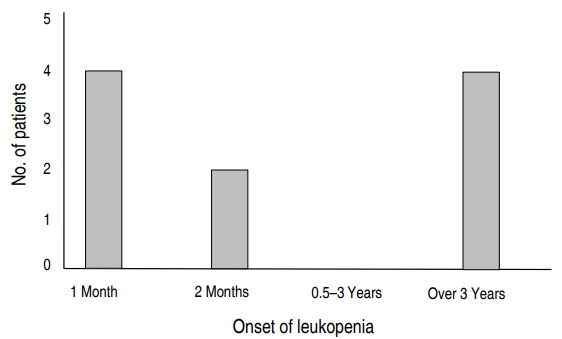
Purpose: The major side effects of treatment with oxcarbazepine (OXC) are skin rash and hyponatremia. Hematologic side effects are reported rarely. The aim of this study was to investigate the rate and types of the hematologic side effects of OXC. Methods: The medical records of 184 patients diagnosed with epilepsy or movement disorder and on OXC monotherapy, at the Department of...
- Review Article
- Neonatology (Perinatology)
- Transfusion practice in neonates
- Do-Hyun Kim
- Clin Exp Pediatr. 2018;61(9):265-270. Published online September 6, 2018
-

Neonates, especially extremely low birth weight infants, are among the groups of patients undergoing transfusion frequently. Since they are exposed to higher specific transfusion risks compared to the patients of other age groups, there are many special aspects that must be considered for transfusion therapy in neonates. The transfusion risks in neonates include adverse outcomes specific for preterm infants as...
- Original Article
- Endocrinology
- The association of total blood mercury levels and overweight among Korean adolescents: analysis of the Korean National Health and Nutrition Examination Survey (KNHANES) 2010–2013
- Yi-Yeon Shin, In-Kyung Ryu, Mi-Jung Park, Shin-Hye Kim
- Clin Exp Pediatr. 2018;61(4):121-128. Published online April 23, 2018
-
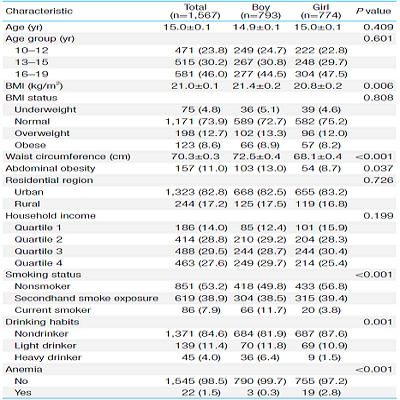
Purpose Obesity has been associated with higher total blood mercury levels, based on animal studies; however, studies that focus on children and adolescents are lacking. We aimed to assess the association between total blood mercury levels and the incidence of overweight and abdominal obesity in Korean adolescents.
Methods The study population comprised 1,567 adolescents (793 boys and 774 girls; aged 10–19 years), who...
- Genetics and Metabolism
- Neonatal indirect hyperbilirubinemia and glucose-6-phosphate dehydrogenase deficiency
- Hasan M. Isa, Masooma S. Mohamed, Afaf M. Mohamed, Adel Abdulla, Fuad Abdulla
- Clin Exp Pediatr. 2017;60(4):106-111. Published online April 25, 2017
-
Purpose This study aimed to determine the prevalence of glucose-6-phosphate dehydrogenase (G6PD) deficiency among infants with neonatal indirect hyperbilirubinemia (NIH); compare G6PD-deficient and G6PD-normal patients regarding hyperbilirubinemia and need for exchange transfusions (ET); and assess risk factors for ET and kernicterus.
Methods This is a case-control retrospective study. Medical records of NIH patients admitted to the Pediatric Department, Salmaniya Medical Complex, Bahrain, between...
- General Pediatrics
- Reference values of lead in blood and related factors among Korean adolescents: the Korean National Health and Nutrition Examination Survey 2010-2013
- Min-Gyu Choi, Mi-Jung Park, Shin-Hye Kim
- Clin Exp Pediatr. 2016;59(3):114-119. Published online March 31, 2016
-
Purpose This study aimed to assess the reference values and factors influencing blood lead levels among Korean adolescents.
Methods The study population consisted of 1,585 adolescents (801 males, 784 females; aged 10-19 years) who participated in the Korea National Health and Nutrition Examination Survey 2010-2013. We analyzed blood lead concentrations in relation to demographic/lifestyle characteristics for all participants. "Reference values" of blood lead...
- Evaluation of three glucometers for whole blood glucose measurements at the point of care in preterm or low-birth-weight infants
- Joon Ho Hwang, Yong-Hak Sohn, Seong-Sil Chang, Seung Yeon Kim
- Clin Exp Pediatr. 2015;58(8):301-308. Published online August 21, 2015
-
Purpose We evaluated three blood glucose self-monitoring for measuring whole blood glucose levels in preterm and low-birth-weight infants.
Methods Between December 1, 2012 and March 31, 2013, 230 blood samples were collected from 50 newborns, who weighed, ≤2,300 g or were ≤36 weeks old, in the the neonatal intensive care unit of Eulji University Hospital. Three blood glucose self-monitoring (A: Precision Pcx, Abbott;...
- Review Article
- Vascular health late after Kawasaki disease: implications for accelerated atherosclerosis
- Yiu-Fai Cheung
- Clin Exp Pediatr. 2014;57(11):472-478. Published online November 30, 2014
-
Kawasaki disease (KD), an acute vasculitis that primarily affects young children, is the most common acquired paediatric cardiovascular disease in developed countries. While sequelae of arterial inflammation in the acute phase of KD are well documented, its late effects on vascular health are increasingly unveiled. Late vascular dysfunction is characterized by structural alterations and functional impairment in term of arterial...
- Original Article
- Correlation between the morning hypertension on ambulatory blood pressure monitoring and the left ventricular mass in children
- Hyun Jung Kim, Kyung Hee Kim, Hong Ryang Kil
- Clin Exp Pediatr. 2014;57(9):403-409. Published online September 30, 2014
-
Purpose Although high morning blood pressure (BP) is known to be associated with the onset of cardiovascular events in adults, data on its effects in children with hypertension are limited. Our retrospective study aimed to define the clinical characteristics of children with morning hypertension (MH) and to determine its associated factors.
Methods We reviewed 31 consecutive patients with hypertension, confirmed by the ambulatory...
- Blood culture contamination in hospitalized pediatric patients: a single institution experience
- Hyewon Min, Cheong Soo Park, Dong Soo Kim, Ki Hwan Kim
- Clin Exp Pediatr. 2014;57(4):178-185. Published online April 30, 2014
-
Purpose Blood culture is the most important tool for detecting bacteremia in children with fever. However, blood culture contamination rates range from 0.6% to 6.0% in adults; rates for young children have been considered higher than these, although data are limited, especially in Korea. This study determined the contamination rate and risk factors in pediatric patients visiting the emergency room (ER)...
- Review Article
- Clinical utilization of cord blood over human health: experience of stem cell transplantation and cell therapy using cord blood in Korea
- Young-Ho Lee
- Clin Exp Pediatr. 2014;57(3):110-116. Published online March 31, 2014
-
Cord blood (CB) has been used as an important and ethical source for hematopoietic stem cell transplantation (SCT) as well as cell therapy by manufacturing mesenchymal stem cell, induced pleuripotential stem cell or just isolating mononuclear cell from CB. Recently, the application of cell-based therapy using CB has expanded its clinical utility, particularly, by using autologous CB in children with...
- Original Article
- The association of blood pressure with body mass index and waist circumference in normal weight and overweight adolescents
- Young-Hwan Song
- Clin Exp Pediatr. 2014;57(2):79-84. Published online February 24, 2014
-
Purpose Overweight can be defined by the body mass index (BMI) and is likely associated with an increased cardiovascular disease risk. However, waist circumference (WC), a central adiposity index, may be a better indicator of cardiovascular disease risk. Studies comparing the effects of BMI and WC on cardiovascular risk factors, such as high blood pressure (BP), are rare in adolescents.
Methods We analyzed...
- The correlation of blood pressure with height and weight in Korean adolescents aged 10-19 years; The Korean National Health and Nutrition Examination Surveys (2009-2011)
- Young-Hwan Song
- Clin Exp Pediatr. 2014;57(1):35-40. Published online January 31, 2014
-
Purpose Height-specific blood pressure (BP) is the standard parameter used to diagnose childhood hypertension. However, there has been some argument that weight may be a better variable than height in the reference BP standards. Therefore, before assessing the BP status using the reference BP standards, a basic understanding of the fundamental association of weight and height with BP is required.
Methods In the...
- The relationships of body mass index, waist-to-height ratio, and body fat percentage with blood pressure and its hemodynamic determinants in Korean adolescents: a school-based study
- Na Young Kim, Young Mi Hong, Jo Won Jung, Nam Su Kim, Chung Il Noh, Young-Hwan Song
- Clin Exp Pediatr. 2013;56(12):526-533. Published online December 20, 2013
-
Purpose Obesity is an important risk factor for hypertension in adolescents. We investigated the relationship of obesity-related indices (body mass index [BMI], waist-to-height ratio [WHR], and body fat percentage [%BF]) with blood pressure and the hemodynamic determinants of blood pressure in Korean adolescents.
Methods In 2008, 565 adolescents, aged 12-16 years, were examined. The %BF of the participants was measured by bioelectrical impedance...
- Association between cord blood 25-hydroxyvitamin D concentrations and respiratory tract infections in the first 6 months of age in a Korean population: a birth cohort study (COCOA)
- Youn Ho Shin, Jinho Yu, Kyung Won Kim, Kangmo Ahn, Seo-Ah Hong, Eun Lee, Song-I Yang, Young-Ho Jung, Hyung Young Kim, Ju-Hee Seo, Ji-Won Kwon, Byoung-Ju Kim, Hyo-Bin Kim, Jung Yeon Shim, Woo Kyung Kim, Dae Jin Song, So-Yeon Lee, Soo Young Lee, Gwang Cheon Jang, Dong In Suh, Hyeon-Jong Yang, Bong Sung Kim, Suk-Joo Choi, Soo-Young Oh, Ja-Young Kwon, Kyung-Ju Lee, Hee Jin Park, Pil Ryang Lee, Hye-Sung Won, Soo-Jong Hong
- Clin Exp Pediatr. 2013;56(10):439-445. Published online October 31, 2013
-
Purpose Previous studies suggest that the concentration of 25-hydroxyvitamin D [25(OH)D] in cord blood may show an inverse association with respiratory tract infections (RTI) during childhood. The aim of the present study was to examine the influence of 25(OH)D concentrations in cord blood on infant RTI in a Korean birth cohort.
Methods The levels of 25(OH)D in cord blood obtained from 525 Korean...
- Analysis of the association between necrotizing enterocolitis and transfusion of red blood cell in very low birth weight preterm infants
- Seon-Yeong Bak, Sihyoung Lee, Jae-Hong Park, Kyu-Hee Park, Ji-Hyun Jeon
- Clin Exp Pediatr. 2013;56(3):112-115. Published online March 18, 2013
-
Purpose To investigate the association between necrotizing enterocolitis (NEC) and red blood cell transfusions in very low birth weight (VLBW) preterm infants.
Methods We studied were 180 VLBW preterm infants who were admitted to the neonatal intensive care unit of CHA Gangnam Hospital from January of 2006 to December of 2009. The subjects were divided into 2 groups: an NEC group (greater than...
- Orthostatic symptoms does not always manifest during tilt-table test in pediatric postural orthostatic tachycardia syndrome patients
- Tae-Eon Huh, Jung Sook Yeom, Young-Soo Kim, Hyang-Ok Woo, Ji Sook Park, Eun Sil Park, Ji-Hyun Seo, Jae-Young Lim, Chan-Hoo Park, Ki-Jong Park, Hee-Shang Youn
- Clin Exp Pediatr. 2013;56(1):32-36. Published online January 29, 2013
-
Purpose Chronic day-to-day symptoms of orthostatic intolerance are the most notable features of postural orthostatic tachycardia syndrome (POTS). However, we have encountered patients with such symptoms and excessive tachycardia but with no symptoms during the tilt-table test (TTT). We aimed to investigate whether POTS patients with chronic orthostatic intolerance always present orthostatic symptoms during the TTT and analyze the factors underlying...
- Review Article
- Umbilical cord blood transplantation
- Hong Hoe Koo, Hyo Seop Ahn
- Clin Exp Pediatr. 2012;55(7):219-223. Published online July 17, 2012
-
Since the first umbilical cord blood transplantation (CBT) in 1998, cord blood (CB) has now become one of the most commonly used sources of hematopoietic stem cells for transplantation. CBT has advantages of easy procurement, no risk to donor, low risk of transmitting infections, immediate availability and immune tolerance allowing successful transplantation despite human leukocyte antigen disparity. Several studies have...
- Original Article
- Hematopoietic stem cell transplantation in children with acute leukemia: similar outcomes in recipients of umbilical cord blood versus marrow or peripheral blood stem cells from related or unrelated donors
- Eun Sang Yi, Soo Hyun Lee, Meong Hi Son, Ju Youn Kim, Eun Joo Cho, Su Jin Lim, Hee Won Cheuh, Keon Hee Yoo, Ki Woong Sung, Hong Hoe Koo
- Clin Exp Pediatr. 2012;55(3):93-99. Published online March 16, 2012
-
Purpose This study compared outcomes in children with acute leukemia who underwent transplantations with umbilical cord blood (UCB), bone marrow, or peripheral blood stem cells from a human leukocyte antigen (HLA)-matched related donor (MRD) or an unrelated donor (URD).
Methods This retrospective study included consecutive acute leukemia patients who underwent their first allogeneic hematopoietic stem cell transplantation (HSCT) at Samsung Medical Center between...
- Validation study of the Dinamap ProCare 200 upper arm blood pressure monitor in children and adolescents
- Chong Guk Lee, Hyang Mi Park, Hye Jung Shin, Jin Soo Moon, Yeong Mi Hong, Nam Soo Kim, Il Soo Ha, Myeong Jin Chang, Kyeong Won Oh
- Clin Exp Pediatr. 2011;54(11):463-469. Published online November 30, 2011
-
Purpose To validate the Dinamap ProCare 200 blood pressure (BP) monitor against a mercury sphygmomanometer in children 7 to 18 years old in accordance with the 2010 International Protocol of European Society of Hypertension (ESH-IP2) and the British Hypertension Society (BHS) protocol.
Methods Forty-five children were recruited for the study. A validation procedure was performed following the protocol based on the ESH-IP2 and...
- A study on the measurement of the nucleated red blood cell (nRBC) count based on birth weight and its correlation with perinatal prognosis in infants with very low birth weights
- Tae Hwan Kil, Ji Yeon Han, Jun Bum Kim, Gyeong Ok Ko, Young Hyeok Lee, Kil Young Kim, Jae Woo Lim
- Clin Exp Pediatr. 2011;54(2):69-78. Published online February 28, 2011
-
Purpose The aim of this study was conducted to investigate the mean nRBC count in very low births weight infants (VLBWIs) and to determine the usefulness of the nRBC as an independent prognostic factors of perinatal complications in VLBWIs.
Methods This study was conducted on 112 VLBWIs who were hospitalized in the neonatal intensive care unit (NICU) of the author's hospital within the...
-

-
-
8.02023CiteScore94th percentilePowered by
-
Impact Factor3.2
-
- TOPICS
- ARTICLE CATEGORY
- Editorial Office
-
Korean Pediatric Society
#1606 Seocho World Officetel, 19 Seoun-ro, Seocho-ku, Seoul 06732, Korea
Tel: +82-2-3473-7306 Fax: +82-2-3473-7307 E-mail: office@e-cep.org
Clinical and Experimental Pediatrics is an open access journal. All articles are distributed under the terms of the Creative Commons Attribution NonCommercial License (http://creativecommons.org/licenses/by-nc/4.0/)
Copyright © 2025 by Korean Pediatric Society.











